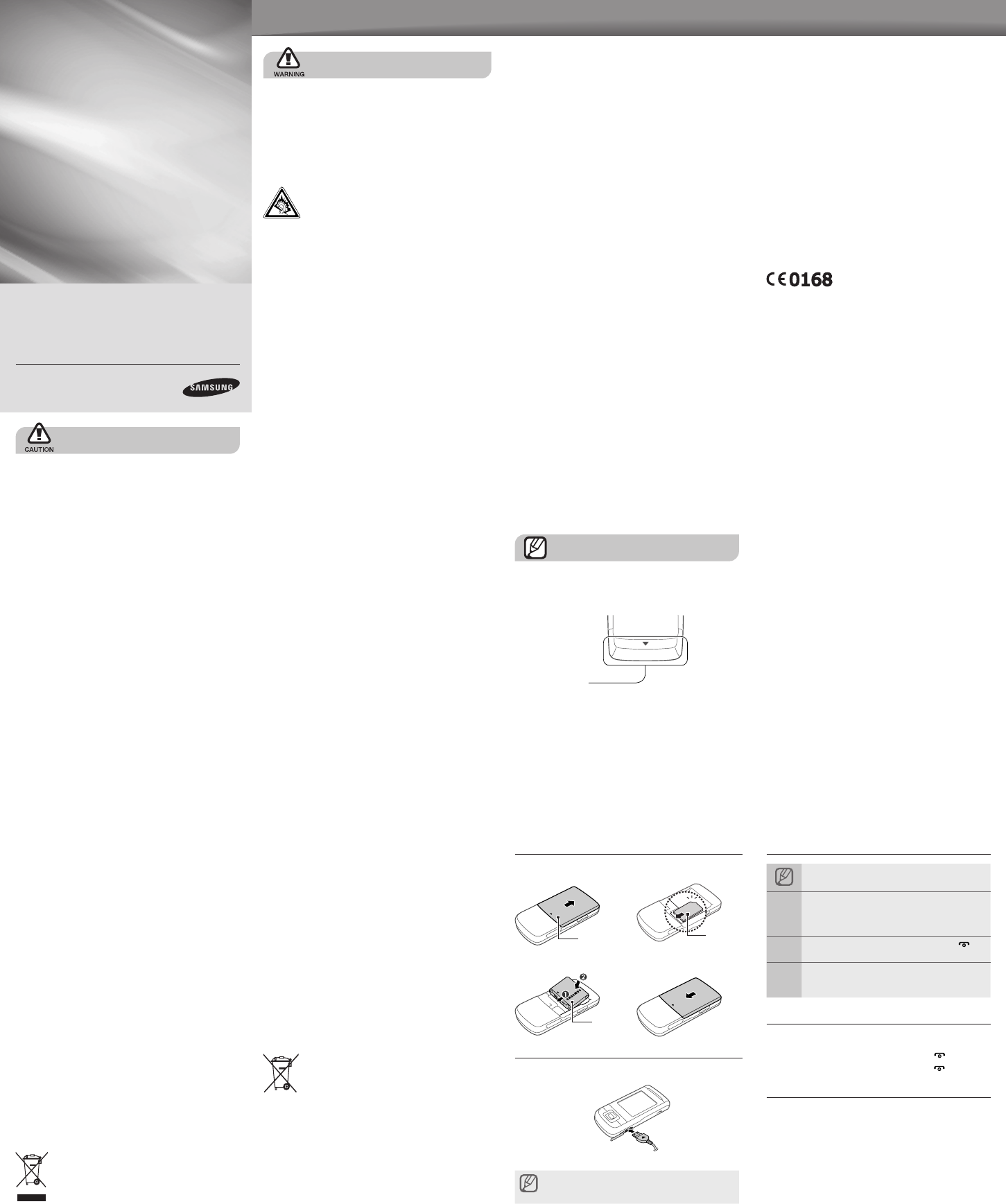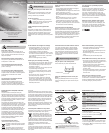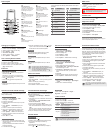
safety and usage information
Comply with the following precautions to avoid dangerous or illegal situations and ensure
peak performance of your mobile phone.
Safety warnings
Keep your phone away from small children and
pets
Keep your phone and all accessories out of the reach
of small children or animals. Small parts may cause
choking or serious injury if swallowed.
Protect your hearing
Listening to a headset at high volumes can
damage your hearing. Use only the minimum
volume setting necessary to hear your
conversation or music.
Install mobile phones and equipment with
caution
Ensure that any mobile phones or related equipment
installed in your vehicle are securely mounted. Avoid
placing your phone and accessories near or in an air
bag deployment area. Improperly installed wireless
equipment can cause serious injury when air bags inate
rapidly.
Safety precautions
Drive safely at all times
Avoid using your phone while driving and obey all
regulations that restrict the use of mobile phones while
driving. Use hands-free accessories to increase your
safety when possible.
Follow all safety warnings and regulations
Comply with any regulations that restrict the use of a
mobile phone in a certain area.
Use only Samsung-approved accessories
Using incompatible accessories may damage your
phone or cause injury.
Turn off the phone near medical equipment
Your phone can interfere with medical equipment in
hospitals or health care facilities. Follow all regulations,
posted warnings, and directions from medical
personnel.
Turn off the phone or disable the wireless
functions when in an aircraft
Your phone can cause interference with aircraft
equipment. Follow all airline regulations and turn off
your phone or switch to a mode that disables the
wireless functions when directed by airline personnel.
Protect batteries and chargers from damage
Avoid exposing batteries to very cold or very hot
temperatures (below 0° C/32° F or above 45° C/
113° F). Extreme temperatures can reduce the
charging capacity and life of your batteries.
Prevent batteries from contacting metal objects, as this
can create a connection between the + and – terminals
of your batteries and lead to temporary or permanent
battery damage.
Never use a damaged charger or battery.
Handle your phone carefully and sensibly
Do not allow your phone to get wet—liquids can cause
serious damage. Do not handle your phone with wet
hands. Water damage to your phone can void your
manufacturer's warranty.
Avoid using or storing your phone in dusty, dirty areas
to prevent damage to moving parts.
Your phone is a complex electronic device—protect
it from impacts and rough handling to avoid serious
damage.
Do not paint your phone, as paint can clog moving
parts and prevent proper operation.
Your phone and memory cards may be damaged
by exposure to magnetic elds. Do not use carrying
cases or accessories with magnetic closures or allow
your phone to come in contact with magnetic elds for
extended periods of time.
•
•
•
•
•
•
•
•
Avoid interference with other electronic devices
Your phone emits radio frequency (RF) signals that
may interfere with unshielded or improperly shielded
electronic equipment, such as pacemakers, hearing
aids, medical devices, and other electronic devices in
homes or vehicles. Consult the manufacturers of your
electronic devices to solve any interference problems
you experience.
Important usage information
Use your phone in the normal position
Avoid contact with your phone's internal antenna.
Allow only qualied personnel to service your
phone
Allowing unqualied personnel to service your phone
may result in damage to your phone and will void your
warranty.
Ensure maximum battery and charger life
Avoid charging batteries for more than a week, as
overcharging may shorten battery life.
Over time, unused batteries will discharge and must
be recharged before use.
Disconnect chargers from power sources when not
in use.
Use batteries only for their intended purpose.
Handle SIM cards and memory cards with care
Do not remove a card while the phone is transferring
or accessing information, as this could result in loss of
data and/or damage to the card or phone.
Protect cards from strong shocks, static electricity,
and electrical noise from other devices.
Frequent writing and erasing will shorten the life span
of memory cards.
Do not touch gold-coloured contacts or terminals with
your ngers or metal objects. If dirty, wipe the card
with a soft cloth.
Ensure access to emergency services
Emergency calls from your phone may not be possible
in some areas or circumstances. Before travelling in
remote or undeveloped areas, plan an alternate method
of contacting emergency services personnel.
•
•
•
•
•
•
•
•
Turn off the phone in potentially explosive
environments
Do not use your phone at refuelling points (service
stations) or near fuels or chemicals. Turn off your phone
whenever directed by warning signs or instructions.
Your phone could cause explosions or re in and
around fuel or chemical storage and transfer areas or
blasting areas. Do not store or carry ammable liquids,
gases, or explosive materials in the same compartment
as the phone, its parts, or accessories.
Reduce the risk of repetitive motion injuries
When sending text messages or playing games on
your phone, hold the phone with a relaxed grip, press
the keys lightly, use special features that reduce the
number of keys you have to press (such as templates
and predictive text), and take frequent breaks.
Handle and dispose of batteries and chargers
with care
Use only Samsung-approved batteries and chargers
specically designed for your phone.
Incompatible batteries and chargers can cause serious
injuries or damage to your phone.
Never dispose of batteries or phones in a re. Follow
all local regulations when disposing used batteries or
phones.
Never place batteries or phones on or in heating
devices, such as microwave ovens, stoves, or
radiators. Batteries may explode when overheated.
Never crush or puncture the battery. Avoid exposing
the battery to high external pressure, which can lead to
an internal short circuit and overheating.
Avoid interference with pacemakers
Maintain a minimum of 15 cm (6 inches) between mobile
phones and pacemakers to avoid potential interference,
as recommended by manufacturers and the independent
research group, Wireless Technology Research. If you
have any reason to suspect that your phone is interfering
with a pacemaker or other medical device, turn off the
phone immediately and contact the manufacturer of the
pacemaker or medical device for guidance.
•
•
•
•
Specic Absorption Rate (SAR) certication
information
Your phone conforms to European Union (EU)
standards that limit human exposure to radio frequency
(RF) energy emitted by radio and telecommunications
equipment. These standards prevent the sale of mobile
phones that exceed a maximum exposure level (known
as the Specic Absorption Rate, or SAR) of 2.0 watts
per kilogram of body tissue.
During testing, the maximum SAR recorded for this
model was 0.295 watts per kilogram. In normal use, the
actual SAR is likely to be much lower, as the phone has
been designed to emit only the RF energy necessary
to transmit a signal to the nearest base station. By
automatically emitting lower levels when possible, your
phone reduces your overall exposure to RF energy.
The Declaration of Conformity at the back of this
manual demonstrates your phones compliance with
the European Radio & Terminal Telecommunications
Equipment (R&TTE) directive. For more information
about the SAR and related EU standards, visit the
Samsung mobile phone website.
Correct disposal of this product
(Waste Electrical & Electronic Equipment)
(Applicable in the European Union and other
European countries with separate collection
systems)
This marking shown on the product or its
literature, indicates that it should not be
disposed with other household wastes at the end of its
working life.
To prevent possible harm to the environment or human
health from uncontrolled waste disposal, please separate
this from other types of wastes and recycle it responsibly
to promote the sustainable reuse of material resources.
Household users should contact either the retailer where
they purchased this product, or their local government
ofce, for details of where and how they can take this
item for environmentally safe recycling.
Business users should contact their supplier and check
the terms and conditions of the purchase contract. This
product should not be mixed with other commercial
wastes for disposal.
Correct disposal of batteries in this product
(Applicable in the European Union and other European
countries with separate battery return systems.)
This marking on the battery, manual or
packaging indicates that the batteries in this
product should not be disposed of with other
household waste at the end of their working
life. Where marked, the chemical symbols Hg, Cd or Pb
indicate that the battery contains mercury, cadmium or
lead above the reference levels in EC Directive 2006/66.
If batteries are not properly disposed of, these
substances can cause harm to human health or the
environment.
To protect natural resources and to promote material
reuse, please separate batteries from other types of
waste and recycle them through your local, free battery
return system.
Install the SIM card and battery
1. Remove the battery cover and insert the SIM card.
2. Insert the battery and replace the battery cover.
Charge the battery
1. Plug the supplied travel adapter.
2. When charging is nished, unplug the travel adapter.
Do not remove the battery from the phone before
unplugging the travel adapter rst. Otherwise, the phone
may be damaged.
Samsung C3110
Printed in Korea
Code No.:GH68-21373A
English (SEA). 12/2008. Rev. 1.1
Mobile Phone
user manual
Some of the contents in this manual may differ
from your phone depending on the software of
the phone or your service provider.
Bluetooth ID : B014646
www.samsungmobile.com
Internal antenna
Battery cover
SIM card
Battery
To AC power outlet
Instructional icons
Note: notes, usage tips, or additional information
Followed by: the order of options or menus you
must select to perform a step; for example: Press
<Menu> Messages (represents Menu, followed
by Messages)
[ ]
Square brackets: phone keys; for example: [ ]
(represents the Power/Menu exit key)
< >
Angled brackets: softkeys that control different
functions at each screen; for example: <OK>
(represents the OK softkey)
Turn your phone on or off
1. Slide open the phone.
2. To turn your phone on, press and hold [ ].
3. To turn your phone off, press and hold [ ].
Access menus
To access your phone's menus,
1. In Idle mode, press <Menu> to access Menu mode.
2. Use the navigation key to scroll to a menu or option.
3. Press <Yes>, <Save>, or the Conrm key to conrm
the highlighted option.




